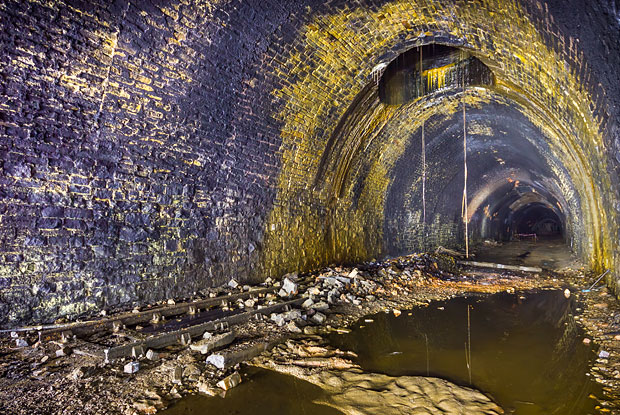Burning Issues
The proposal to lay a shared path through Queensbury Tunnel raises a number of related issues. We are keen to address every one of them. This is an unusual project and it is only to be expected that people will have questions to which they want answers. We will endeavour to do so on this page. If you have one we haven't covered, please email us.
 |
|
© Forgotten Relics
|
Opening the tunnel would be a waste of money.
Actually, that's what we're trying to avoid. The tunnel is looked after by the Historical Railways Estate (HRE), part of Highways England, on behalf of the Department for Transport. Subject to funding, HRE intends to carry out a multi-million pound programme of works on the tunnel over the next few years to ensure it doesn't present a threat to the public, particularly those living on the line of the tunnel close to the shafts. That's a perfectly reasonable thing for them to do: they are simply discharging their statutory responsibility.
However those works will result in the ends of the tunnel being filled with concrete and the structure abandoned. Effectively, all that money - provided by you, the taxpayer - would be buried and lost with it.
In our view, repairing the tunnel (which could be done for about the same cost) would deliver real value for money from that investment, allowing the structure to play a long-term role that benefits the public. Converting it to host a shared path would do that, for reasons set out on our Goals & Gains page. page.
Opening the tunnel would attract crime.
Nowhere is immune from crime - city or village, main road or alleyway - and it would be unrealistic to expect the tunnel to be any different. How could it be; why should it be?
But let's take a look at tunnels from a criminal's perspective. Having committed an illegal act, they need to make their escape, but a tunnel provides only one way in and one way out. They can't disappear into the bushes or melt away over the fields. And with only two entrances, it's easy to cover them with CCTV.
Experience elsewhere has been positive. That's not to say all reopened railway tunnels have been crime-free zones, but they have not become the hotspots for criminality and anti-social behaviour that many feared. And the greater the throughput of people (the more a tunnel is used), the less attractive they are to those with unlawful intentions. There is safety in numbers.
Looking at the bigger picture, should a fear of criminality be allowed to deny the law-abiding majority positive new experiences? Every venture comes with risks, but isn't it better to manage those risks rather than suffer the social paralysis that comes with setting the bar unreasonably high? If we succumb to that culture, we stifle progress.
The tunnel would not be safe if the ventilation shafts were filled in.
The ventilation shafts are all capped and have been for many years; they don't have any effect on air flow.
Like every other, Queensbury Tunnel has a natural system of ventilation thanks to the difference in temperature and/or air pressure between the two ends. This results in part from the 1:100 gradient through the tunnel whereby the north end is 23 metres (75 feet) higher than the south end.
Whilst this was not sufficient in the days of steam trains to clear away all the smoke, it would be adequate for those on foot or cycles to pass through safely.
The tunnel's lining is not safe and could collapse on someone.
There would be no question of opening the tunnel to the public unless/until it was in a suitable condition. As things stand, several sections of lining have suffered distortion due to ground movement and need support to prevent them collapsing. Two already have. But these issues are all summountable.
The majority of the lining is in good or fair condition although high-volume minor works would be needed to repair those areas where bricks have spalled/fallen or there has been considerable mortar loss. All that is both doable and costed.
The tunnel is too wet for the public to use.
During its operational period (1878-1956), Queensbury was notorious for being a wet tunnel. However repair work would reduce the amount of water ingress via the shafts and rerouting a water course near the northern entrance back into the culvert built to accommodate it - rather than it discharging into the cutting - would prevent a lot of water from entering the tunnel at that end. Where water penetrates the lining, pans and pipes can be fitted to channel it into the track drainage which would need to be repaired or renewed.
The tunnel would not be bone dry but it would be much more hospitable than it is today.
|

